DRAGE
Context
[Damien Picard's PhD thesis]Reconfigurable Computing (RC) aims to use
the flexibility of the configurable logic proposed by FPGA
components to enhance computation performance. The common idea is
that RC fills the gap between a general purpose
Von Neumann architecture (microprocessor) and a highly specific
full custom architecture (ASIC -
application specific integrated circuit) by programming an
appropriate architecture.
Microprocessor performances are limited by the
sequential behavior while ASICs suffer the
definitive silicon implementation. FPGA components appear as a
trade off between these two alternatives: a same physical support can be
re-programmed (or reconfigured) to support any suitable
architectures. Hence, reconfigurable computing claims to add both
the flexibility of the programming machines and
the speed of specific architectures.
The reality is not so obvious. First, an FPGA
architecture is much slower than its ASIC
counterpart. This is mainly due to
its programmable nature, which requires
signals to pass along many programmable
electronic switches, compared to a direct silicon
implementation.
Coarse grained architectures reduce this effect by sizing up logical
grain.
Second, the synthesis of a specific architecture onto a FPGA component
is still a long and error-prone process that remains far to
be completely automated. The architecture to implement
is often specified in VHDL, and requires a
lot of simulation steps to be validated.
In addition, a design designed
with a particular reconfigurable platform in mind sticks to this
target and exhibits poor re-use: the portability between different
configurable platforms is not ensured due to the lack
of programming model.
A way for increasing flexibility is to define a virtual FPGA
structure. In that case, an architecture is not
defined relatively to a specific FPGA component,
but relatively to a virtual FPGA structure
which will be implemented across the different
existing platforms and across their next generations.
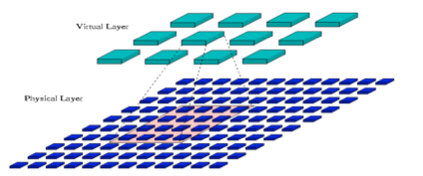 |
Virtual FPGA is a concept that was first introduced in Placing,
Routing, and Editing Virtual FPGAs [Ref] |
As for virtual machine, such as the JVM (Java
Virtual Machine), we must deal with the loss
of performance introduced by the virtual layer. In our
case a virtual structure will have a limited amount of resources
(virtual logic blocks) and the clock speed will be slowed
down compared to a real FPGA
component. To keep performance reasonable
one could specialize the virtual structure toward
a specific field of applications. In that case,
integrating into the virtual level domain specific functions
could balance the extra-cost.
If designing a range of specialized virtual FPGA structures
targeted to various application
domains will guarantee a
minimum of performance, one has to
wonder how these architectures will be
programmed. More precisely, the problem is to
get the appropriate
utility programming tools, such as, for example, the
place-and-route step, for each specialized FPGA structure
developed. Of course, we cannot imagine to rewrite
from scratch another set of tools each time a new FPGA structure
is proposed.
DRAGE
Next figure shows a simple example of PicoGA inspired architecture. IOs are located on the left side. Computations are organized as rows, with registers and multiplexers based connections between rows. Used resources appear as blue lines (wires) and red boxes (ALUs).

Next figure illustrates the flow. Only the left side makes sense here. The process starts from a ADL description of the target from which we derive (MDE approach) a custom tool suite and a VHDL description of the target supporting multi context and partial/dynamic reconfiguration.
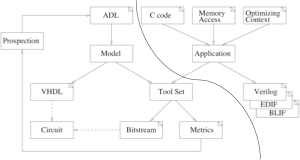
A simple mesh architecture appears as a matrix of basic cells embedding a switch bloc and a LUT.
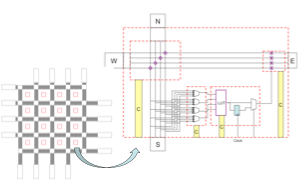
The full description is automatically computed to simplify border
cells.
A configuration manager is provided. Several options can be activated
such as adding several configuration layers for configuration
pre-fetching.
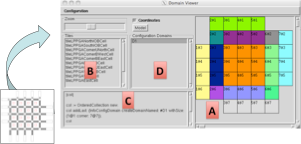
The bistream structure conforms to the reconfiguration page granularity the designer has chosen.
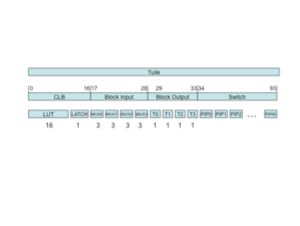
A layout with a microblaze supporting a Coarse Grained Reconfigurable Architecture extension.






